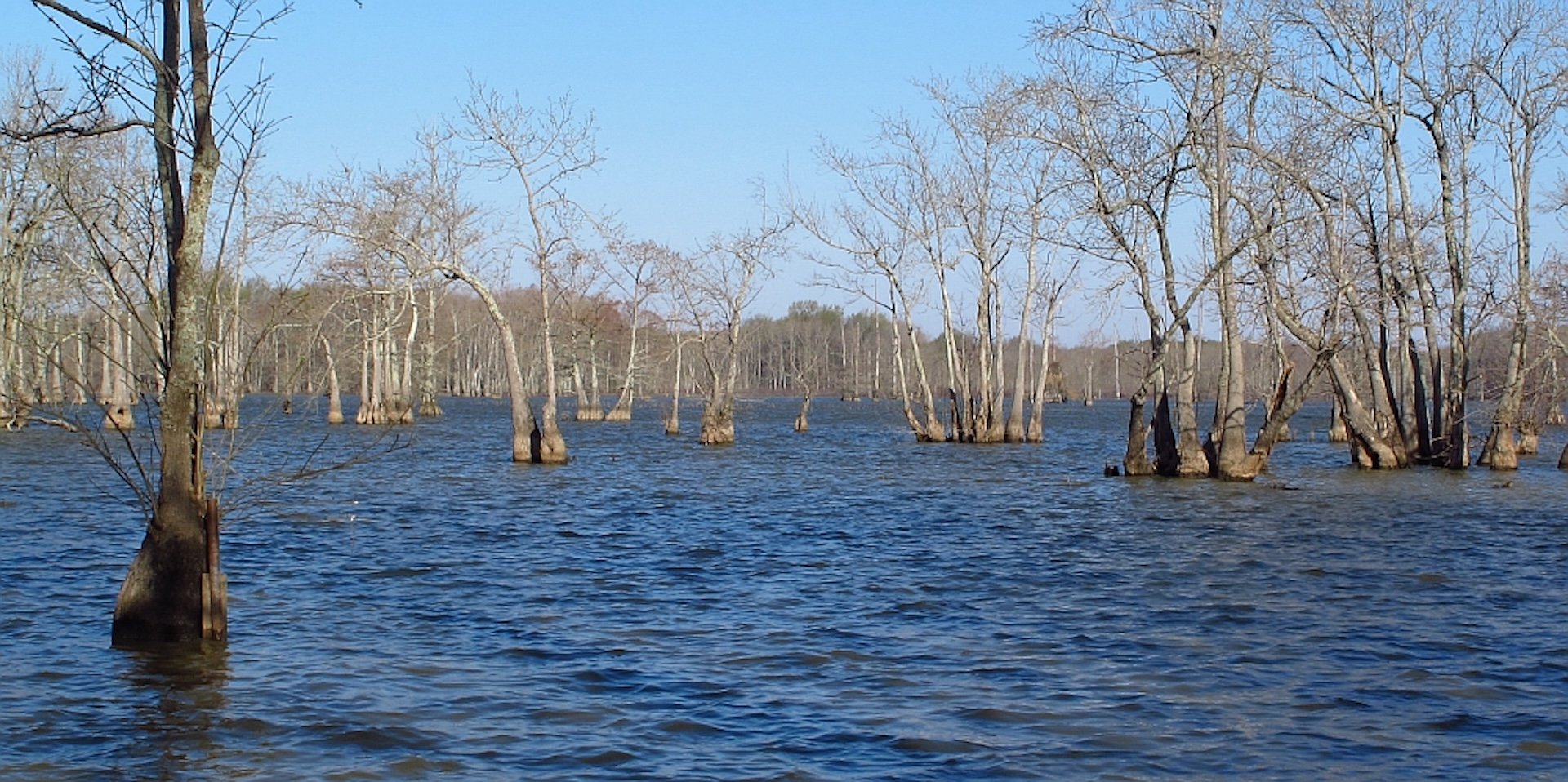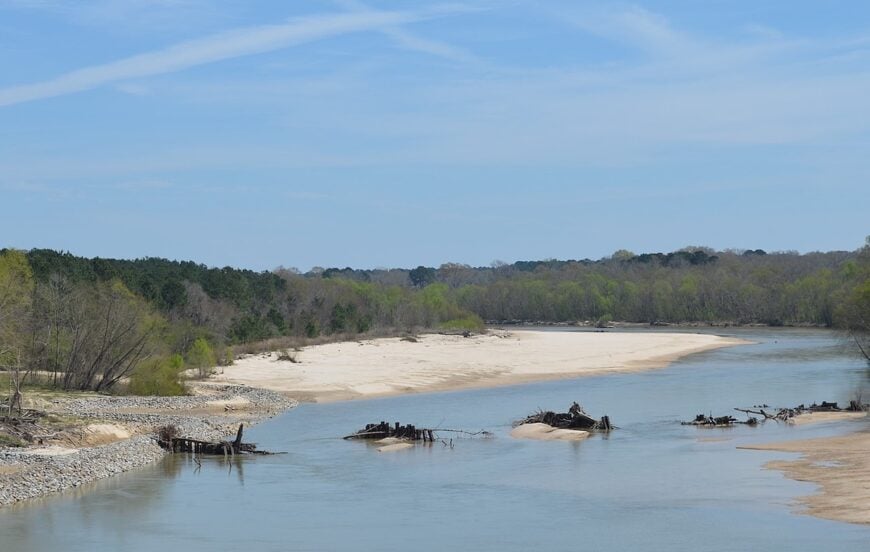
Driving south from Natchez, the pavement thins to two lanes, and the horizon shifts between pine ridges and low stretches of clay. Mailboxes appear in clusters, then vanish into long gaps of pasture and woods. It’s in these spaces that the towns of Southwest Mississippi take shape—not as destinations on a signpost, but as communities tied to their terrain.
Each settlement has its own anchor. A church standing at the center of a crossroads, a courthouse square shaded by oaks, a store where the week’s conversations gather with the groceries. Some hold visible layers of history in brick storefronts or abandoned depots, while others have little more than a scattering of houses strung along a road.
The pace is not invented for visitors. It comes from the rhythm of work—logging trucks on the highways, cattle moving between fields, fields themselves marked by seasons rather than schedules. The quiet here is not absence but a record of continuity, of people accustomed to living with wide margins of land and time.
This list of 25 towns brings those margins into view. It traces communities across Jefferson, Adams, Amite, Franklin, and Lincoln counties, showing how seclusion is not simply a retreat but the everyday condition of life in this part of Mississippi.
25. Church Hill – Live Oaks, Red Clay, and Sunday Quiet

Church Hill drifts across hilltops north of Natchez, where live oaks lean over red-clay lanes and white-steepled churches crown the ridges. The settlement feels suspended in time—historic homes behind split-rail fences, pasture gates creaking, and little traffic except on Sunday mornings.
Its seclusion comes from being wrapped in plantation countryside and far from commercial corridors. Wander past the iconic Church Hill Presbyterian Church, photograph oak allées, birdwatch along creek bottoms, or follow dirt roads that fade into pasture.
Cattle, timber, and heritage upkeep form the local rhythm rather than retail. When evening falls, the quiet is broad enough to hear crickets in the grass. It’s the kind of hush that makes you breathe differently.
Where is Church Hill?
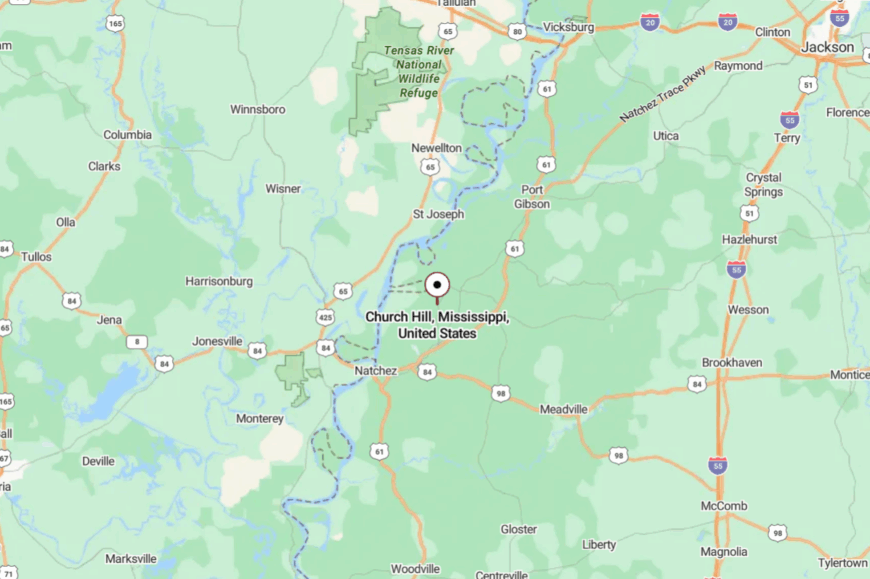
Tucked in Jefferson County near the Adams County line, Church Hill sits about 18 miles north of Natchez. Most travelers reach it via MS-553, branching from US-61 before the road narrows to country lanes.
There’s no town square to announce your arrival—just oaks and old churches. It’s close to Natchez yet far enough to feel like you slipped behind the scenery.
24. Kingston – River Bluffs and River Stories
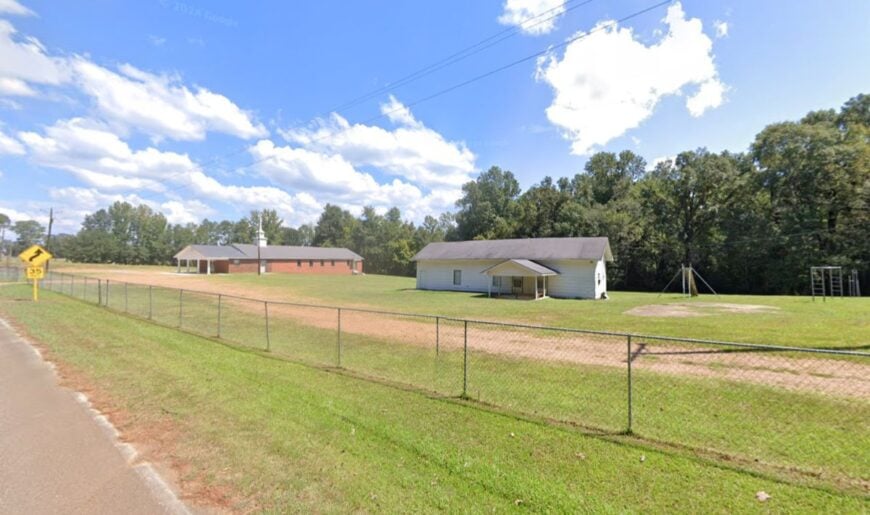
Kingston sprawls low and quiet south of Natchez, a cluster of homes and fields tucked near the Mississippi River bluffs. It feels rural and reverent—old cemeteries, clapboard chapels, and wind in the cane along creek mouths.
Seclusion comes from the patchwork of private lands and the way backroads loop into themselves. Trace history at country churches, fish the nearby oxbows, photograph moss-draped trees at daybreak, or drive slow under cathedral-tall oaks.
Farming and timber shape the calendar more than clocks. Twilight brings whip-poor-wills that stitch the evening together. Kingston is the whisper after the river’s long sentence.
Where is Kingston?

Set in Adams County about 16 miles southeast of Natchez, Kingston hides just off US-61 on Kingston Road. Access is a few easy turns that quickly become narrower, quieter lanes.
With no commercial strip, there’s little reason to pass through unless you intend to. You’ll know you’re there when the trees start talking.
23. Sibley – Pines, Pastures, and a Post-Road Pace
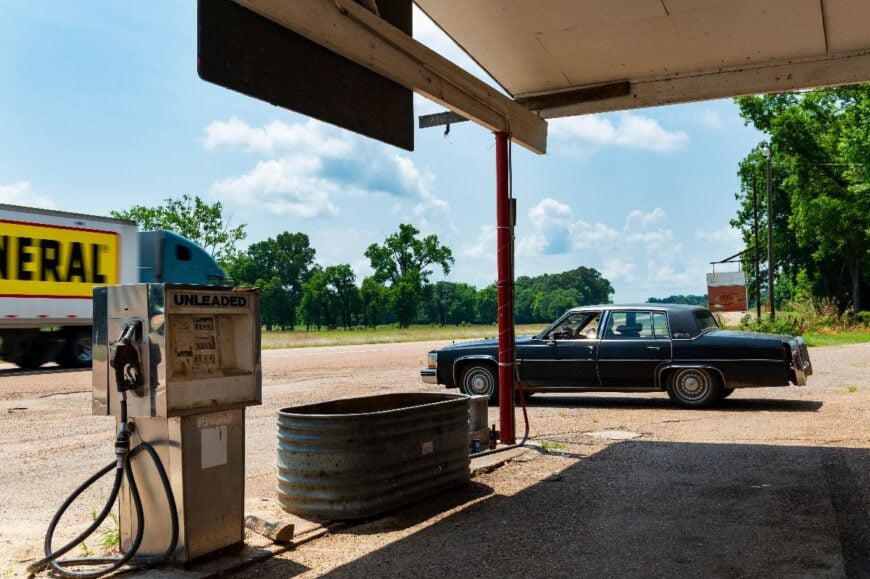
Sibley keeps to itself in the folds of southern Adams County, where pines give way to little pastures and mailboxes sit a long walk apart. The vibe is unhurried—dogs nap in the shade, and the loudest thing all afternoon might be a cicada chorus.
Its tucked-away feel comes from meandering county roads and a lack of through-traffic. Cast a line in nearby ponds, ramble gravel lanes for sunrise photos, stop at a country store for a cold soda, or roll the windows down and let the pine scent in.
Forestry and small farms are the heartbeat here. Night lies down like a quilt. Sibley reminds you that quiet can be an address.
Where is Sibley?

Sibley rests about 10 miles south of Natchez in Adams County, a short jog off US-61 onto Sibley Road. The route becomes rural almost immediately, with fences and woods closing ranks.
There’s no main street to chase, only pockets of homes and fields. It’s close enough for groceries in town, far enough to forget town exists.
22. Woodville – Courthouse Oaks and Backroad Time

Woodville wears history lightly: a handsome courthouse square shaded by enormous oaks, and side streets that drift into old neighborhoods. Despite being a county seat, it feels secluded, surrounded by vast timberlands and plantations that keep development at arm’s length.
Morning light on wrought-iron balconies and the smell of fresh-cut pine set the tone. Browse antique shops, tour the historic district, explore nearby Clark Creek Natural Area’s waterfalls, or take a slow loop down scenic plantation roads.
Forestry and county offices anchor the economy without stirring much bustle. Even the trains seem to pass softer here. Woodville is proof that a town can be central and hidden at the same time.
Where is Woodville?
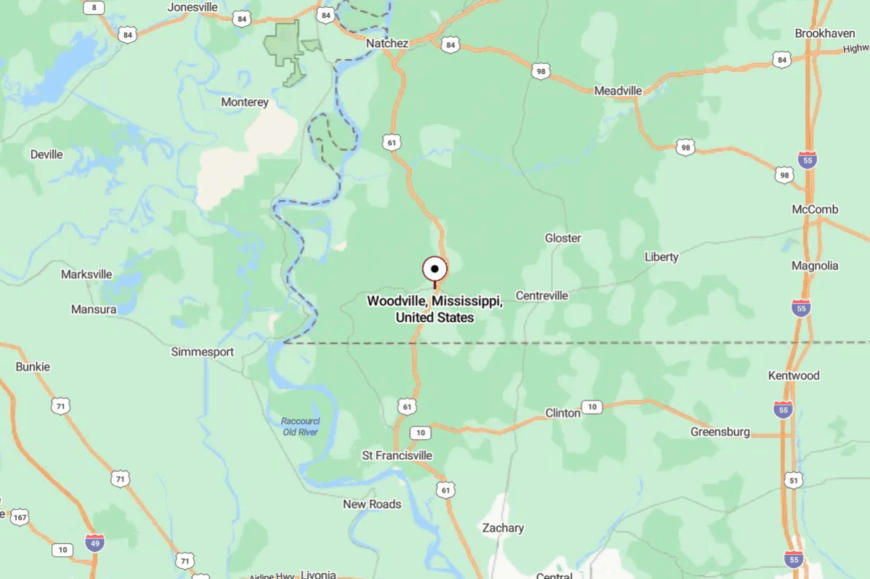
In deep Wilkinson County, Woodville sits about 30 miles south of Natchez at US-61 and MS-24. Approaches are two-lane and tree-lined; once you’re off 61, the world shrinks to oaks and brick.
There’s no interstate for miles, which keeps the pace deliberate. It feels like a destination you choose rather than stumble upon.
21. Centreville – Borderland Porches and Long Shadows

Centreville straddles county lines and eras at once—broad porches, tall shade trees, and storefronts that close early. Its seclusion is geographic and cultural; you’re out where sawmills, pastures, and creeks keep their own counsel.
The town mood is friendly but soft-spoken, the kind that waves from a pickup and lets you pass. Grab a plate lunch downtown, walk past century-old facades, fish quiet farm ponds with permission, or follow MS-24 to shadowy forest edges.
Timber and small businesses carry the load here. Evenings stretch long and amber over the fields. Centreville feels like a pause that lasts all day.
Where is Centreville?

On the Wilkinson/Amite line, Centreville lies roughly 50 miles south of Natchez and 49 miles northwest of Baton Rouge. It’s reached via MS-24 and MS-33, both easy two-lanes that soon slip into woods.
With no interstate nearby, you arrive unhurried. The slow approach is half the spell.
20. Gloster – Piney Woods and Mill Whistles Gone Quiet

Gloster is a timber town wrapped in pine, where the old mill rhythm lingers even when the machinery sleeps. Seclusion here is the work of endless forest and the absence of big highways slicing through.
The vibe is sturdy, modest, and deeply local—church suppers, hardware counters, and long, straight roads between trees. Hike the Homochitto edges, scout forest service roads, visit the depot museum, or park under loblollies for a picnic. Logging and outdoor work are still the backbone.
At night, the wind in the pines is a steady hush. Gloster is where the woods set the metronome.
Where is Gloster?

In southern Amite County, Gloster is about 55 miles south of Natchez and 20 miles west of Liberty. Use MS-24/MS-33 to reach town, then smaller streets take over.
The map turns green fast, and cell bars thin to a rumor. It’s a straight shot on paper, but a world apart in person.
19. Bude – Porch Lights by the National Forest

Bude lives quietly beside Homochitto National Forest, its neighborhoods tucked behind pines and porches that glow warm after supper. The town feels like a base camp for simple pleasures—walks at dusk, fishing plans, the smell of rain on hot pavement.
Seclusion comes from being flanked by forest and bypassed by hurry. Cast for bream in local lakes, bike low-traffic streets, stop in at the old downtown, or day-trip to forest trailheads. Timber and small shops share the work week.
When the sun drops, the crickets take attendance. Bude is a soft landing in a big green room.
Where is Bude?

Set in Franklin County just east of Meadville, Bude sits along US-84 with quick access to forest roads. Turn off the highway and you’re instantly in neighborhoods edged with trees.
The national forest keeps the edges quiet. It’s easy to find and easier to forget the world once you arrive.
18. McCall Creek – One Store, A Few Porches, Endless Sky

McCall Creek is a hamlet in the truest sense—an old store, a scattering of homes, and pasture rolling to the trees. Its seclusion is self-evident: few addresses, fewer streetlights, and nights that feel larger than the map.
The mood is peaceful and practical, built on farming, forestry, and neighborly favors. Pick up a snack at the country store, photograph sunrise over hay bales, watch hawks work the thermals, or take a Sunday drive beneath the pines.
The calendar is set by seasons, not schedules. If you crave quiet, it waits here without effort. McCall Creek is the echo after the day is done.
Where is McCall Creek?

In western Franklin County, McCall Creek lies about 9 miles west of Meadville along US-84. Access is simple, but the moment you turn off, the world becomes fences and fields.
There’s no town center to linger in—only space. It’s a dot on the map with a wide horizon.
17. Eddiceton – Depot Memories and Pine Shadows
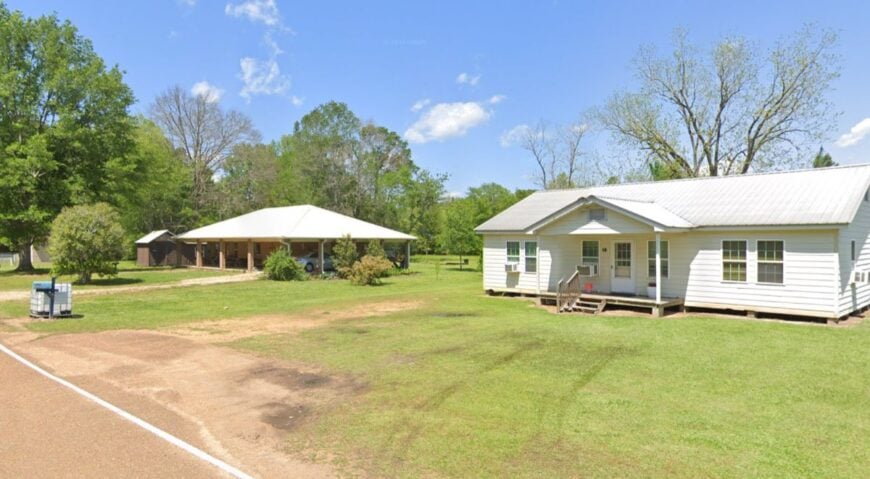
Eddiceton gathers itself around an old rail crossing and the memory of a depot, surrounded by tall pines that quiet the road noise. It feels spare and historic—weathered outbuildings, sandy shoulders, and an occasional train horn far off.
Seclusion comes from the small scale and the forest at its edges. Check out the historic Eddiceton Bridge site, stroll sandy lanes for wildflowers, picnic beneath longleafs, or follow US-84 to nearby trailheads.
Timber and ranching stitch together the week. After sunset, stars arrive unchallenged. Eddiceton is where the past and the pines agree to keep things simple.
Where is Eddiceton?

Located in central Franklin County right on US-84, Eddiceton sits about 6 miles east of Meadville. Despite the highway, turnoffs quickly narrow to quiet lanes.
With a national forest close by, development thins fast. It’s accessible—but intentionally unassuming.
16. Smithdale – Ridge Farms and Gravel Lanes
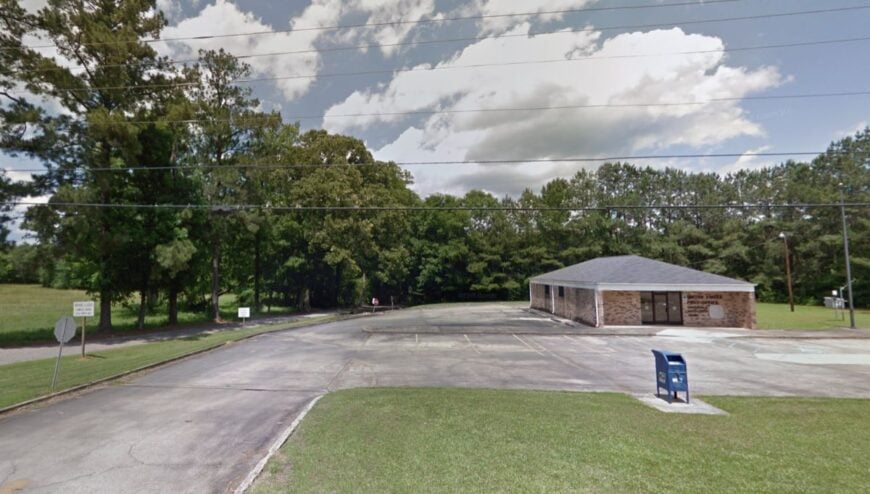
Smithdale spreads across ridges and hollows where cattle graze and gravel lanes knit one homestead to the next. The town vibe is practical and kind—feed-store conversations, Sunday dinners, and trucks dusted with red clay.
Its seclusion comes from long distances between neighbors and a map of roads that favor curves over shortcuts. Fish farm ponds with permission, roll backroads for sunset vistas, browse a seasonal produce stand, or detour to nearby Homochitto trailheads.
Ranching and logging pay the bills here. The quiet settles like dew in the evenings. Smithdale is a small name for a wide quiet.
Where is Smithdale?

In northern Amite County, Smithdale is roughly 15 miles northwest of McComb and 20 miles east of Liberty. Approach via MS-569 or MS-570, both easy two-lanes that soon turn to quieter roads.
There’s no downtown to seek—just clusters of mailboxes and pasture gates. It’s the journey that explains the place.
15. Ruth – A Few Corners of Peace

Ruth is a crossroads in Lincoln County where the post office, a church, and a store sketch the outline of a town. It feels unhurried and genuine—garden rows, porch swings, and the soft thump of screen doors.
Seclusion is baked in: houses sit far apart, and tall pines soften every sound. Walk shaded lanes, cast into farm ponds at dawn, pick blackberries on fence rows, or simply count the stars after dark.
Farming and commuting blend without changing the pace. Night here is dark in the best way. Ruth is where simplicity has room to breathe.
Where is Ruth?

Ruth lies about 16 miles southeast of Brookhaven in Lincoln County, near MS-583. Getting there means two-lane roads and generous shoulders of pine.
There’s no reason for heavy traffic to pass through. It’s close to town, far from town’s habits.
14. Pattison – Bayou Pierre Breezes and Porch-Light Evenings

Pattison is a soft-spoken village where porches face broad shade trees and bayou breezes rustle the leaves like quiet conversation. Its tucked-away feel owes to a net of two-lane roads, forest edges, and farmland that keeps any hurry at bay.
The town vibe is friendly and old-fashioned—church suppers, kids on bikes, and screen doors thumping at supper time. Explore Canemount Wildlife Management Area for birding and woodland walks, roll the Natchez Trace Parkway to historic stops, fish quiet bends along Bayou Pierre, or wander backroads lined with hayfields and pecan trees.
Work here leans toward small trades, farming, and nearby commutes, none of it loud. Night brings chorus frogs and the faint smell of woodsmoke. Pattison is where the day ends gently and the quiet stays.
Where is Pattison?
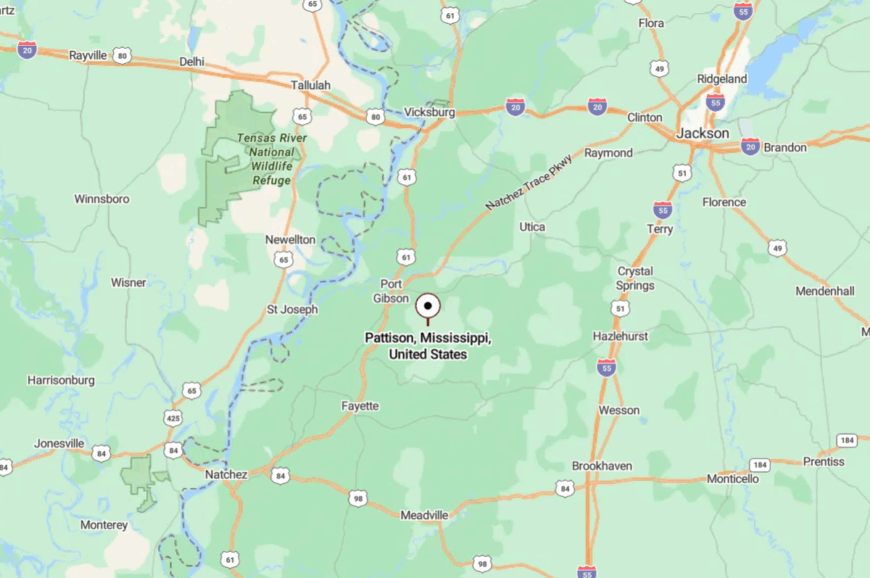
Located in Claiborne County, Pattison lies about 30 miles south of Vicksburg and 25 miles northeast of Natchez. Arrive via US-61 and MS-547, then let local lanes guide you past fields and timber.
With no interstate slicing through, the approach feels deliberate and calm. It’s close enough to navigate easily, yet far enough to feel like you’ve stepped off the main road of life.
13. Fernwood – Pines, Porches, and a Faded Sign

Fernwood lingers just south of McComb, a pocket of porches, pines, and the ghost of a grand old resort era. It feels like a hush between exits—rail lines, shade trees, and neighborhoods hidden from the highway’s hurry.
Seclusion comes from the way local roads dead-end into timber or bend back on themselves. Walk the quiet grid at golden hour, hunt vintage finds, photograph rail spurs, or slip up to nearby lakes and trails for an afternoon.
Commerce is modest; life is mostly residential and rooted. Dusk sounds like sprinklers and cicadas. Fernwood is the quiet margin on the page.
Where is Fernwood?

Fernwood sits in Pike County about 4 miles south of McComb, just east of US-51 and west of I-55. Despite the proximity, neighborhood streets keep traffic local.
You arrive in minutes, then forget the interstate exists. It’s the definition of near yet tucked away.
12. Jayess – Fencerows, Faith, and Far Horizons

Jayess is a rural scatter of homes and churches in Lawrence County, a landscape of long fencerows and hay fields that lift to the big sky. The mood is humble and spacious—work trucks, produce stands, and Sunday socials that last past sunset.
Its seclusion is geographic: far from city centers and served by a two-lane highway that prefers curves to speed. Browse farm stands, birdwatch along hedgerows, take a sunset drive toward the Pearl River, or detour to quiet creeks for a picnic.
Agriculture and commuting hold the week steady. Nights are still enough to hear the owls trade notes. Jayess is the solitude people mean when they say “country.”
Where is Jayess?
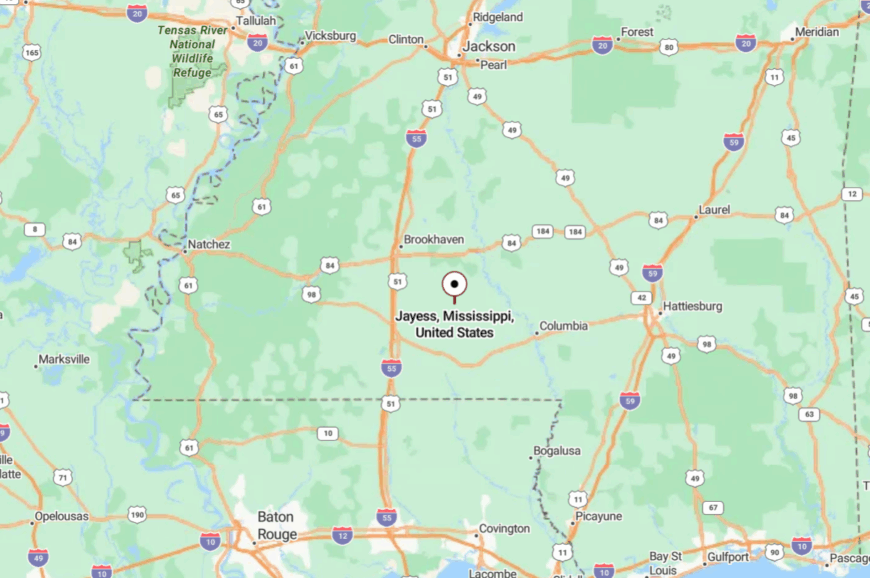
North of Tylertown in Lawrence County, Jayess lies near MS-27 and MS-44, about 20 miles east of the Louisiana line. Approaches are all two-lane and all pretty.
There’s no town center pull—just pockets of homes and fields. You’ll know you’ve arrived when the horizon opens up.
11. Lorman – Windsor Ruins and Oak-Shadowed Lanes

Lorman feels like a chapter from an old Mississippi novel, where oak canopies arch over sandy lanes and the wind carries the scent of pine and river bottom. Its seclusion comes from miles of plantation countryside, scattered homesteads, and a two-lane approach that keeps life unhurried.
The vibe is reverent and historic—white-steepled churches, quiet fields, and long afternoons that seem to stretch. Visit the hauntingly beautiful Windsor Ruins, walk the gracious greens of Alcorn State University, cruise the Natchez Trace Parkway for scenic overlooks, or photograph moss-draped oaks at golden hour.
Small farms, campus life, and heritage tourism set a gentle rhythm rather than a rush. After dusk, crickets take over and the night sky feels close. It’s the kind of place where history and hush share the same porch.
Where is Lorman?

Set in Jefferson County in far Southwest Mississippi, Lorman sits about 30 miles northeast of Natchez and 45 miles southwest of Vicksburg. Most travelers reach it via US-61, then slip onto MS-552 and local roads that narrow beneath live oaks.
With the Natchez Trace nearby but no interstate in sight, traffic thins to a murmur. It’s close enough for a day trip, far enough to feel beautifully removed.
10. Gillsburg’s Rural Bliss

Gillsburg, with its modest population of just a few hundred residents, embodies the essence of rural bliss in Southwest Mississippi. Nestled amidst vast open spaces and rolling farmlands, I find that this quaint community offers a peaceful retreat from the bustle of modern life.
One of the town’s most notable points of interest is the memorial site of the 1977 Lynyrd Skynyrd plane crash, adding a touch of historical significance to the serene landscape. The mainstay of Gillsburg’s economy is agriculture, with many locals engaged in farming and forestry, contributing to the town’s rustic charm.
For those who enjoy outdoor activities, the surrounding countryside provides ample opportunities for hunting, fishing, and simply absorbing the tranquility of nature.
Gillsburg’s seclusion is accentuated by its sparse population and the enveloping rural scenery, making it an ideal spot for anyone seeking a true escape into country living.
Where is Gillsburg?

Located in the southwestern corner of Mississippi, Gillsburg sits near the Louisiana border within Amite County. Its position away from major highways and urban centers enhances its secluded ambiance.
The town is surrounded by dense woods and farmland, which not only provide privacy but also a picturesque backdrop for daily life.
To reach Gillsburg, I usually take the winding country roads off Interstate 55, embracing the gradual transition from busy routes to peaceful lanes—a journey that itself sets the tone for the quietude that awaits.
9. Hamburg: The Ultimate Hideaway

Hamburg, a tiny enclave with a population of just a few hundred, is truly one of Mississippi’s ultimate hideaways. Tucked deep within Franklin County, I appreciate how this community is enveloped by expansive woodlands and undeveloped lands, offering unparalleled privacy to its residents.
Outdoor enthusiasts can explore the nearby Homochitto National Forest, which provides a plethora of activities like hiking, camping, and bird watching in an untouched natural setting. The local economy is primarily supported by small-scale agriculture and forestry, reflecting the town’s strong connection to the land.
With minimal commercial development, Hamburg remains largely untouched by the fast-paced changes of the outside world. Its remote location and the abundance of nature make it a perfect refuge for those seeking solitude and a slower pace of life.
Where is Hamburg?

Hamburg is nestled in the heart of Franklin County in Southwest Mississippi, near the Homochitto River. Its seclusion comes from being off the beaten path, far from major highways and urban centers.
Surrounded by vast stretches of forests and rural countryside, I’ve found that the journey to Hamburg involves traversing scenic backroads that emphasize the town’s remoteness.
To get there, you typically navigate through a network of state and county roads branching off from U.S. Route 84, embracing the peaceful drive that gently leads you into this hidden gem.
8. Sontag: Serenity Among the Pines

Sontag, home to a few hundred people, offers a serene setting nestled among the dense pine forests of Southwest Mississippi. I love how this small community is surrounded by nature, creating a haven of solitude that’s hard to find elsewhere.
The town is perfect for those who enjoy outdoor activities like hiking and wildlife watching, with the nearby Lake Mary Crawford providing fishing and picnicking opportunities. The local economy is modest, centered around forestry and small-scale farming, which adds to the town’s quiet, rural charm.
What really sets Sontag apart is its low population density and the enveloping forests, providing residents with privacy and a deep connection to nature. This seclusion makes Sontag an ideal spot for anyone looking to escape the hustle and bustle of city life.
Where is Sontag?

Located in Lawrence County, Sontag is situated in a remote part of Southwest Mississippi, away from major urban areas. Its seclusion is enhanced by the extensive pine forests that surround it, creating natural barriers from the outside world.
Getting to Sontag involves taking winding country roads that meander through the lush landscape, a journey that I find both peaceful and scenic. The closest major road is U.S. Highway 84, but from there, you venture onto smaller state routes, embracing the tranquility that intensifies as you draw nearer to this secluded haven.
7. Cannonsburg’s Hidden Heritage

Cannonsburg is a small community steeped in history, with an estimated population of just a few hundred residents. I find its historical significance intriguing, as it’s home to antebellum sites and rich stories from Mississippi’s past.
The town offers a peaceful environment where you can explore historical landmarks or simply enjoy the tranquility of rural life. The local economy is quiet, with little commercial activity, allowing the historical charm to remain unspoiled by modern development.
Cannonsburg’s seclusion is one of its greatest assets, providing a serene escape where you can step back in time. The absence of bustling industries means the town maintains a calm ambiance, perfect for anyone seeking a quiet, history-rich retreat.
Where is Cannonsburg?

Located in Jefferson County, Cannonsburg lies in the southwestern region of Mississippi, between the towns of Fayette and Natchez. Its secluded nature is partly due to its distance from major roads and cities, which keeps it off the usual tourist trails.
To get there, I typically take the scenic Route 61, also known as the Blues Highway, before branching off onto smaller local roads that lead into the heart of this historic community. The journey through rolling hills and dense woods sets the stage for the peaceful atmosphere that Cannonsburg generously offers.
6. Union Church: Nestled in Nature

Union Church is a charming community with a population hovering around a few hundred, making it an intimate and close-knit place to live. I admire its rustic setting, surrounded by gently rolling hills and thick forests that provide a natural barrier from the outside world.
The town is known for its historic Union Church Presbyterian Church, a beautiful structure dating back to the 19th century. Agriculture and forestry are predominant here, with many residents engaged in farming activities that sustain the local economy.
What makes Union Church truly secluded is the enveloping natural landscape, which not only offers breathtaking views but also a tranquil environment away from the hustle of city life. It’s a perfect spot for those who appreciate a rural lifestyle in harmony with nature.
Where is Union Church?

Nestled in Jefferson County, Union Church sits comfortably between Jackson and Natchez, yet remains distant enough to retain its seclusion. The town is tucked away from major highways, enhancing its quiet atmosphere and ensuring minimal traffic and noise.
When I visit, I usually take State Route 28 or State Route 550, both leading through picturesque countryside before arriving in Union Church. This journey emphasizes the town’s remote location, surrounded by natural beauty that seems untouched by time.
5. Osyka: The Quiet Southern Retreat

Osyka, with a modest population of around 450 residents, is a charming town that embodies the essence of a quiet Southern retreat. I enjoy strolling through its quaint streets, lined with historic buildings that whisper tales of bygone eras.
The town offers simple pleasures—a peaceful park, local eateries, and antique shops reflecting its rich heritage. The primary industries here are small businesses and agriculture, contributing to a laid-back lifestyle that residents cherish.
Osyka’s seclusion comes from its location far from bustling city centers, allowing for a tranquil environment where time seems to slow down. It’s an ideal spot for privacy seekers who appreciate a community that values peace and simplicity.
Where is Osyka?

Situated in Pike County, Osyka lies near the Mississippi-Louisiana border in the southwestern part of the state. Its secluded nature is heightened by its distance from major urban areas and interstates.
To reach Osyka, I often take Interstate 55 but then exit onto smaller state roads that meander through the countryside before arriving in town. The journey itself underscores the peaceful isolation of Osyka as you leave behind the rush of the highway for the serenity of rural landscapes.
4. Roxie’s Remote Charm

Roxie, home to just under 500 residents, exudes remote charm that immediately captivates anyone seeking a quiet place to unwind. I find the town’s quiet streets and historic homes evoke a sense of nostalgia that’s hard to come by in today’s fast-paced world.
Surrounded by lush woodlands, Roxie offers ample opportunities for outdoor activities like hiking and hunting in the nearby Homochitto National Forest. The local economy revolves around agriculture and forestry, industries that blend seamlessly with the town’s natural surroundings.
What sets Roxie apart is its true seclusion—residents here enjoy a lifestyle deeply connected to nature and free from the distractions of urban life.
Where is Roxie?

Roxie is located in Franklin County, nestled in the rolling hills of Southwest Mississippi. Its secluded position is due in part to its distance from major highways and cities, offering a refuge from the hustle and bustle.
To get to Roxie, I prefer taking U.S. Route 84 and then venturing onto smaller county roads that lead into the heart of this peaceful town. The journey takes you through scenic landscapes, reinforcing the sense of remoteness that makes Roxie such a special place.
3. Liberty: Embracing Small-Town Peace

Liberty, with a population of around 700 residents, is a town that fully embraces the peace and simplicity of small-town life. I’ve always been drawn to its close-knit community, where neighbors know each other and there’s a strong sense of camaraderie.
The town offers charming historical sites, including the Amite County Courthouse and several antebellum homes. Local shops and eateries add to the town’s quaint appeal, while the surrounding countryside provides ample space for outdoor activities.
Liberty’s spacious living and lack of urban development create a peaceful, secluded environment that’s perfect for those looking to escape the noise and fast pace of larger cities.
Where is Liberty?

Situated in Amite County, Liberty lies in Southwest Mississippi, not far from the Louisiana border. The town’s seclusion is enhanced by its rural surroundings and minimal through traffic, as it’s nestled away from major highways.
When driving to Liberty, I often take State Route 24 or State Route 48, routes that wind through picturesque farmland and forests before arriving in town. This location, coupled with its small size, makes Liberty a haven for anyone seeking the tranquility of rural Mississippi.
2. The Tranquil Landscapes of Meadville

Meadville, with a population of approximately 450 residents, offers expansive natural scenery that provides a serene escape from urban life. I enjoy the town’s tranquil atmosphere, surrounded by the rolling hills and forests of Franklin County.
Meadville serves as a gateway to the Homochitto National Forest, making it an ideal location for hiking, camping, and exploring the great outdoors. The local economy is primarily based on timber and agriculture, industries that harmonize with the town’s natural setting.
Meadville’s isolation from larger cities allows for a peaceful lifestyle where residents can immerse themselves in the beauty of Southwest Mississippi’s landscapes.
Where is Meadville?

Located in the heart of Franklin County, Meadville is nestled amidst the lush greenery that characterizes the region. Its secluded nature stems from its distance from major urban centers and transportation hubs.
Getting to Meadville involves taking U.S. Route 84, but the town itself feels worlds away from the highway’s bustle. I find that the approach to Meadville, through dense forests and gentle terrain, emphasizes the tranquility that defines this hidden gem.
1. Crosby: Mississippi’s Best-Kept Secret

Crosby, with a population of just over 300 residents, truly feels like Mississippi’s best-kept secret. Nestled amidst dense forests along the Homochitto River, I find Crosby’s hidden allure irresistible. The town is steeped in rich, untapped history, with roots dating back to the early 20th century when it thrived as a lumber town.
Today, Crosby offers a peaceful environment where nature takes center stage, perfect for those who appreciate the quiet melodies of the wilderness.
The absence of bustling industries and commercialization has allowed Crosby to maintain its authentic charm, making it a unique destination for anyone looking to step off the beaten path. Its secluded location amidst thick woodlands not only provides privacy but also a deep sense of connection with the natural world.
Where is Crosby?

Situated on the border of Amite and Wilkinson counties in Southwest Mississippi, Crosby lies close to the Louisiana state line. The town’s seclusion is a result of its remote location, surrounded by the Homochitto National Forest and far from major highways.
When I journey to Crosby, I take winding state roads that lead through miles of untouched forest, enhancing the feeling of entering a secluded haven. Accessing Crosby involves careful navigation of these lesser-known routes, but the reward is a tranquil setting that feels like a world apart from the hustle of modern life.



